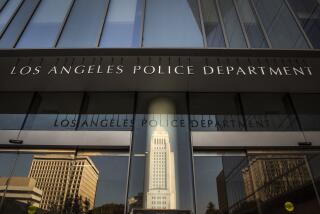Defensive Driver Makes Judge See Light
- Share via
Memo to City Hall: You can’t fight Alice Jordan.
Don’t even try.
The city of Fountain Valley made that mistake recently, thinking it could nail Jordan, 65, with a traffic ticket. Tried to convince her and a judge that she ran a red light at the intersection of Warner and Euclid. Thought she was just going to sit there and cough up $271 in fines. Plus who knows what it would do to her car insurance.
The nerve of these people.
Just because she and her husband live down in Del Mar, they probably figured she wouldn’t challenge the ticket in an Orange County courtroom.
Ha!
Here’s the best way to explain Jordan’s courtroom prowess: The officer was right, and Jordan still won.
The incident occurred in November, when Jordan prepared to turn south onto Euclid from the westbound turn lane on Warner.
The way she saw it, the arrow was green when she entered the intersection and red by the time she got through. That’s what the patrolman saw too--at least, the red part. He wrote her up.
The battle was on.
Knowing (in her mind) that she didn’t have enough time to get through the intersection, Jordan contacted Fountain Valley traffic engineers and asked them about the timing of the light. They stiffed her, she says.
Undaunted, she queried a San Diego-area traffic engineer. They told her what she needed from Fountain Valley.
“I ended up with a timing sheet for that day at that intersection,” she explains to me. “You ever heard of a timing sheet?”
“No,” I reply.
“Neither had I,” she says, laughing.
The sheet indicated that the yellow light was supposed to hold for four seconds.
“The person in San Diego said it might be a malfunctioning detector loop,” Jordan says. So, she and her husband returned to Orange County a couple of times and parked where they could test the light. Their findings: The yellow light was holding for only two seconds.
Exhibit A: the ‘Detector Loop’
She checked back with Fountain Valley and discovered the last time that light had been checked for performance was July 1994.
Thus was hatched her “detector loop” defense.
It was just a matter of taking her case to court, which she did last week.
“I did a helluva job,” Jordan says. “The police officer showed up, so I had to face him.”
That prospect hadn’t pleased her. “I’d wake up in the middle of the night and be in court,” she says.
Her strategy was to get the officer to answer no to a question or two. She figured that would be reasonable doubt.
On court day, Jordan had butterflies. “I went out and ate something beforehand, but up until about a half-hour before [court], I felt like I was going to lose my lunch. Once I got inside the courtroom, I thought, ‘OK, this is it. Pull it together.’ ”
She had her questions mapped out.
“I wanted to give him an easy question to start him out, so I asked him where he was when he spotted me,” Jordan says.
The second question was how many other cars entered the intersection with her. He wasn’t sure.
Then, the big one.
“The third question was mean,” she says, gleefully. “I asked if he was aware the lights were short or malfunctioning. Of course, his answer to that was no. When he said no, I said, ‘I am.’ ”
Retired lawyer Arthur Folger served as judge. He hears between 70 and 80 cases a month and rules for the defendant maybe once or twice.
Faced with Jordan’s research, he had no choice.
“There was doubt in my mind whether or not the phasing of the light was correct,” he says. Employing a standard of reasonable doubt, he ruled for Jordan.
I ask Folger if he remembers Jordan.
Sure, he says. “When you talk to her, give her my best.”
To Jordan, victory meant more than saving the fine. “I just thought it was outrageous because I knew I had done no wrong,” she says. “I guess I had to prove to myself and whoever else that my word is my honor.”
Even so, did she consider that she might lose?
“Oh, sure,” she says. “I had my checkbook along with me.”
Dana Parsons’ column appears Wednesday, Friday and Sunday. Readers may reach Parsons by calling (714) 966-7821 or by writing to him at the Times Orange County Edition, 1375 Sunflower Ave., Costa Mesa, CA 92626, or by e-mail to dana.parsons@latimes.com.
More to Read
Sign up for Essential California
The most important California stories and recommendations in your inbox every morning.
You may occasionally receive promotional content from the Los Angeles Times.













